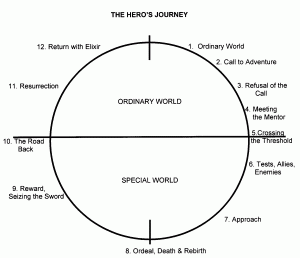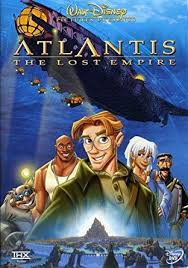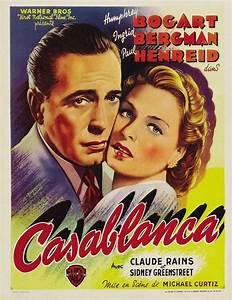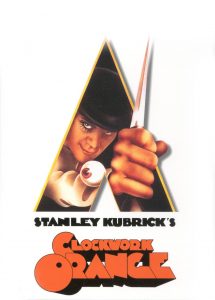
I’m going to give you some hard truths about story structure, and try to impress upon you that, while everything you’ve ever been told about story structure is not necessarily wrong, there is a different way to look at story structure that makes sense both from a macro and a micro point of view. If you read this blog with any regularity, you know that I am an advocate of solid story structure, especially for unknown writers who are trying to break in to the business.
In order to avoid controversy, I’ve stuck to the 3-Act mantra, and you can go back through all of my blogs on the subject, and I always refer to it as 3-Act structure, except for one random blog I posted a little over a year ago. Then I taught a class on story structure for Stage 32, and I decided that I needed to speak the truth. As much as we want to believe what we’ve always been told, it’s time to accept the fact that stories are more often than not told in four acts, not three.
We’ve always been taught that the proper way to write a screenplay is to write it in three acts with the first act being 25-30 pages, the second act being 50-60 pages and the third act being anther 25-30 pages. The reason for that is because of the power of 3. Everything should have a beginning, a middle and an end. That makes total sense, and while there are exceptions to that rule, it’s easy to look at almost any mainstream American film of the last 90 years and see that basic beginning, middle and end structure.
However, there is a different way to look at it. I, too, had been told about 3-act structure in my early days of learning about screenwriting. Then, one day I started taking intermediate screenwriting at USC, and the instructor opened by talking about 4-act structure. He didn’t make a big deal out of it. He just started talking about writing your screenplay in 4 acts. “He’s gotta be misspeaking,” I told myself. Everyone knows it’s 3 acts. I had friends who asked me about his class after I’d been in it for a few weeks, because everyone knew that he was pushing this 4-act idea which felt very controversial to them, again, because everyone had always been told, “3 acts, 3 acts, 3 acts.”
Being an open-minded, non-confrontational, go-with-the-flow kind of guy, I thought to myself, let’s split the difference. It can still be 3 acts, but I’ve seen plenty of graphs and charts that show Act IIA and Act IIB, so it’s really no big deal. Then I graduated from USC and I got a job at Disney working on the feature, Atlantis: The Lost Empire. Now, Atlantis will never be mistaken for the greatest Disney feature ever, but it did show me that yes, movies can be told in 4 distinct acts, because Atlantis, whether directors Kirk Wise and Gary Trousdale or screenwriter Tab Murphy, or anyone from the story team intended it, Atlantis is told in four acts. The Set Up. The Conflict / Adventure. The Consequences / Adventure. And the Resolution / Climax.

Milo Thatch is the Hero of the story and his outer goal is to find Atlantis. Well, he and his friends find Atlantis half way through the picture. In Act I, Milo is trying to convince the members of the board of the Smithsonian to fund an expedition to find Atlantis and is laughed out of the building. He then finds an eccentric billionaire who was friends with his grandfather and knows about the Shepherd’s Journal, which has clues that Milo is able to put together to determine Atlantis’ final resting place, and this billionaire has already put the team together. They just need Milo’s expertise. So at the end of Act I, the story changes direction as the adventure begins when they all board the submarine to find Atlantis. Then, at the midpoint of the film, they find it. The story changes direction again at the end of Act IIA (really Act II) as Milo now wants to learn as much about Atlantis as he can. That’s the definition of changing the Act. The story changes direction. Then Milo discovers that Rourke, the leader of the expedition has a much darker purpose for wanting to find Atlantis, the story changes direction again at the end of Act IIB (really Act III), as Milo now wants to save Atlantis, and we move into the Resolution / Climax of the story, which is Act III (really Act IV).
That got me to thinking about movies that I had seen and scripts that I had read, and the more I thought about it, the more I realized that most screenplays really are told in four acts. I am a disciple of Christopher Vogler, and I have studied the Hero’s Journey extensively. In fact, when I read scripts for coverage, I often use the Hero’s Journey as a means of evaluating, and as a means of offering up suggestions for improvement. Looking at this Hero’s Journey graph at the top, if you were to extend the vertical lines, we would see that the structure of the story is actually broken up into quadrants. Quad obviously being four. The first act starts in the Ordinary World. It sets up the problem that the hero will have to face, and usually introduces us to most of the important characters. We also learn what problem or problems the hero will need to overcome. The second act is where the adventure begins, and the hero is facing that problem. The midpoint of the story, referred to in the Hero’s Journey as the Ordeal, is often where the original problem is either solved or some other problem arises. Another common refrain for the portion of the story is that this is where the stakes are raised. In Atlantis, the stakes are raised when they discover Atlantis. It isn’t the end of the adventure; it’ the beginning of a new one. As we’ll see shortly, in Raiders of the Lost Ark, they discover the Ark half way through the movie. If the movie was just about finding the Ark, it should have ended at that point, but now the stakes are being raised, because they have to keep it away from the Nazis. That is when we move in to Act III, where we have to deal with the consequences of those stakes being raised. This generally leads to the moment where the hero loses everything, or has some comparable low point, and we transition from Act III in to Act IV. Act IV is where we have our resolution and climax.

Raiders of the Lost Ark is clearly a film that is told in four acts. Act I, Indy learns about the Ark, and that the Nazis are searching for it. In Act II, Indy searches for the Ark, and discovers it at the half-way point of the film. Act III is all about Indy attempting to get the Ark safely into the hands of the Allies and out of the hands of the Nazis, however the act ends with the Nazis getting the Ark from him, but also kidnapping Marion. Act IV shows Indy as a changed man, who was previously willing to sacrifice Marion for the Ark, but now would prefer to rescue her over getting the Ark back from the Nazis. However, overcoming that character flaw allows him to do both, and the movie ends with him losing the Ark to the Washington, D.C. bureaucracy, but gaining Marion back into his life.
Another great example is Casablanca. A four-act feature in which each act shows a different aspect of Rick’s personality. Not only that, but Act’s I and II are transposed via one of the great flash backs in the history of cinema.

Casablanca actually starts in Act II. We have already entered into the Special World of Casablanca, and we start out the film being introduced to all of the wild and fantastical characters that live there. The Tests, Allies and Enemies portion of the Hero’s Journey starts the movie. We meet Ugarte, Renault, Major Strasser, Ferrari, but most important of all, we meet Rick, who famously will stick his neck out for no one. We learn that he used to be a warrior for justice and underdogs, but those days are past. He’s now a cynical loner, apparently bereft of feelings or emotion.
Ilsa’s arrival marks the Approach. Rick is now inevitably heading to a confrontation with Ilsa, and that confrontation will be the Ordeal, but we don’t yet know why there is tension between them or where it came from.
The Supreme Ordeal is wrapped around the flashback that takes us to Act I, Rick’s Ordinary World, which was Paris. We see his loving nature and good humor. He loves Ilsa, and he loves Paris. He seems to be a lover of life. However, all of that changes when the Nazis march into Paris and Rick thinks that Ilsa will leave on the last train out with him. However, all that he gets is a note from her, telling him that she can never see him again. With that note, the young, loving and idealistic Rick dies and is replaced by the cynical, hard-boiled Rick who only looks out for himself.
Part 2 of the Supreme Ordeal shows Ilsa giving Rick a second call to adventure by asking for the letters of transit that he’d gotten from Ugarte. Rick provides a second refusal. Now we’re in Act III as Rick starts to grow as a character. He still loves Ilsa, but his bitterness doesn’t allow him to forgive her just yet.
Act IV shows Rick back as the selfless person he once was. He chooses the path that’s best for others rather than himself, but is finally comfortable in his own skin.

One final example of 4-Act structure is A Clockwork Orange. That movie clearly is told in three acts with Alex’s Ordinary World being the one in which he spends his nights doing the old ultra-violence with his droogs. Act II begins when Alex is arrested for murder, and he’s sent to the Special World of Prison. Act III begins when Alex is selected to receive the Ludivico treatment to make him good. Act IV shows Alex, a new man entirely, returning home only to find that he’s not wanted by his family and friends, and the people that he wronged in the past are lusting for revenge. This leads to a powerful climax and poses moral questions that can only be answered individually by anyone who watches the film.
On a macro level, thinking of your story from this point of view should make it easier to write an entire script. Rather than thinking of Act 2 as a 60 page monster, you really should be thinking of it as two sections of the story, with each one having to change the direction of the story. Instead of 2 equal acts bookending a larger act in the middle, the story should be thought of as being broken down into 4 equal sections.
Not only should the overall story be broken down like that, but so should your scenes. Each scene or sequence is its own story with someone trying to accomplish something, and some person or thing or force of nature is trying to stop that from happening.
And if you were to analyze most films, you’ll find that they match this story structure. Are there exceptions? Of course, there are. However, the vast majority of scripts are written in four acts, and the most compelling and most interesting stories are told with that structure.